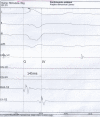Local electrogram delay recorded from left ventricular lead at implant predicts response to cardiac resynchronization therapy: retrospective study with 1 year follow up
- PMID: 22607487
- PMCID: PMC3447687
- DOI: 10.1186/1471-2261-12-34
Local electrogram delay recorded from left ventricular lead at implant predicts response to cardiac resynchronization therapy: retrospective study with 1 year follow up
Abstract
Background: Considerable proportion of patients does not respond to the cardiac resynchronization therapy (CRT). This study investigated clinical relevance of left ventricular electrode local electrogram delay from the beginning of QRS (QLV). We hypothesized that longer QLV indicating more optimal lead placement in the late activated regions is associated with the higher probability of positive CRT response.
Methods: We conducted a retrospective, single-centre analysis of 161 consecutive patients with heart failure and LBBB or nonspecific intraventricular conduction delay (IVCD) treated with CRT. We routinely intend to implant the LV lead in a region with long QLV. Clinical response to CRT, left ventricular (LV) reverse remodelling (i.e. decrease in LV end-systolic diameter - LVESD ≥10%) and reduction in plasma level of NT-proBNP >30% at 12-month post-implant were the study endpoints. We analyzed association between pre-implant variables and the study endpoints.
Results: Clinical CRT response rate reached 58%, 84% and 92% in the lowest (≤105 ms), middle (106-130 ms) and the highest (>130 ms) QLV tertile (p < 0.0001), respectively. Longer QRS duration (p = 0.002), smaller LVESD and a non-ischemic cardiomyopathy (both p = 0.02) were also univariately associated with positive clinical CRT response. In a multivariate analysis, QLV remained the strongest predictor of clinical CRT response (p < 0.00001), followed by LVESD (p = 0.01) and etiology of LV dysfunction (p = 0.04). Comparable predictive power of QLV for LV reverse remodelling and NT-proBNP response rates was observed.
Conclusion: LV lead position assessed by duration of the QLV interval was found the strongest independent predictor of beneficial clinical response to CRT.
Figures



Similar articles
-
Longer right to left ventricular activation delay at cardiac resynchronization therapy implantation is associated with improved clinical outcome in left bundle branch block patients.Europace. 2016 Apr;18(4):550-9. doi: 10.1093/europace/euv117. Epub 2015 Jun 27. Europace. 2016. PMID: 26116830 Free PMC article.
-
Comparison of measures of ventricular delay on cardiac resynchronization therapy response.Heart Rhythm. 2020 Apr;17(4):615-620. doi: 10.1016/j.hrthm.2019.11.023. Epub 2019 Nov 22. Heart Rhythm. 2020. PMID: 31765805 Clinical Trial.
-
Longer Left Ventricular Electric Delay Reduces Mitral Regurgitation After Cardiac Resynchronization Therapy: Mechanistic Insights From the SMART-AV Study (SmartDelay Determined AV Optimization: A Comparison to Other AV Delay Methods Used in Cardiac Resynchronization Therapy).Circ Arrhythm Electrophysiol. 2016 Nov;9(11):e004346. doi: 10.1161/CIRCEP.116.004346. Circ Arrhythm Electrophysiol. 2016. PMID: 27906653 Clinical Trial.
-
Assessment of mechanical dyssynchrony in cardiac resynchronization therapy.Dan Med J. 2014 Dec;61(12):B4981. Dan Med J. 2014. PMID: 25441737 Review.
-
Comparative efficacy of image-guided techniques in cardiac resynchronization therapy: a meta-analysis.BMC Cardiovasc Disord. 2021 May 24;21(1):255. doi: 10.1186/s12872-021-02061-y. BMC Cardiovasc Disord. 2021. PMID: 34024286 Free PMC article. Review.
Cited by
-
Time-related factors predicting a positive response to cardiac resynchronisation therapy in patients with heart failure.Sci Rep. 2023 May 26;13(1):8524. doi: 10.1038/s41598-023-35174-9. Sci Rep. 2023. PMID: 37237039 Free PMC article.
-
High-density epicardial activation mapping to optimize the site for video-thoracoscopic left ventricular lead implant.J Cardiovasc Electrophysiol. 2014 Aug;25(8):882-888. doi: 10.1111/jce.12430. Epub 2014 May 12. J Cardiovasc Electrophysiol. 2014. PMID: 24724625 Free PMC article.
-
Rationale and design for ENHANCE CRT: QLV implant strategy for non-left bundle branch block patients.ESC Heart Fail. 2018 Dec;5(6):1184-1190. doi: 10.1002/ehf2.12340. Epub 2018 Sep 27. ESC Heart Fail. 2018. PMID: 30264456 Free PMC article. Clinical Trial.
-
Prognostic value of reverse remodelling criteria in heart failure with reduced or mid-range ejection fraction.ESC Heart Fail. 2021 Aug;8(4):3014-3025. doi: 10.1002/ehf2.13396. Epub 2021 May 18. ESC Heart Fail. 2021. PMID: 34002938 Free PMC article.
-
Inadvertent QRS prolongation by an optimization device-based algorithm in patients with cardiac resynchronization therapy.PLoS One. 2022 Sep 26;17(9):e0275276. doi: 10.1371/journal.pone.0275276. eCollection 2022. PLoS One. 2022. PMID: 36155997 Free PMC article.
References
-
- Bristow MR, Saxon LA, Boehmer J, Krueger S, Kass DA, De Marco T, Carson P, DiCarlo L, DeMets D, White BG. et al.Cardiac-resynchronization therapy with or without an implantable defibrillator in advanced chronic heart failure. N Engl J Med. 2004;350(21):2140–2150. doi: 10.1056/NEJMoa032423. - DOI - PubMed
-
- Linde C, Abraham WT, Gold MR. St John Sutton M, Ghio S, Daubert C: Randomized trial of cardiac resynchronization in mildly symptomatic heart failure patients and in asymptomatic patients with left ventricular dysfunction and previous heart failure symptoms. J Am Coll Cardiol. 2008;52(23):1834–1843. doi: 10.1016/j.jacc.2008.08.027. - DOI - PubMed
-
- Cazeau S, Leclercq C, Lavergne T, Walker S, Varma C, Linde C, Garrigue S, Kappenberger L, Haywood GA, Santini M. et al.Effects of multisite biventricular pacing in patients with heart failure and intraventricular conduction delay. N Engl J Med. 2001;344(12):873–880. doi: 10.1056/NEJM200103223441202. - DOI - PubMed
Publication types
MeSH terms
Substances
LinkOut - more resources
Full Text Sources
Medical
Research Materials

